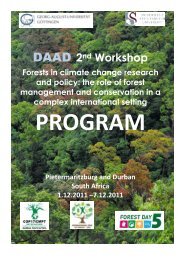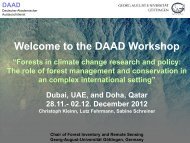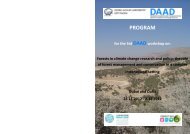Proceedings of the Workshop - Georg-August-Universität Göttingen
Proceedings of the Workshop - Georg-August-Universität Göttingen
Proceedings of the Workshop - Georg-August-Universität Göttingen
You also want an ePaper? Increase the reach of your titles
YUMPU automatically turns print PDFs into web optimized ePapers that Google loves.
among o<strong>the</strong>rs. During <strong>the</strong>se sessions it was <strong>of</strong> central importance to provide capacity<br />
building for community leaders, in order to assure <strong>the</strong> long term success <strong>of</strong> <strong>the</strong> project.<br />
(2) Environmental classrooms: this component was directed towards primary<br />
school children and to selected community members who were trained by project<br />
members and ano<strong>the</strong>r NGO´s like INBio (Biodiversity National Institute) as<br />
environmental educators. Project classrooms were built and provided with <strong>the</strong><br />
necessary equipment and materials concerning <strong>the</strong> environmental topic.<br />
(3) Environmental Festivals: These festivals were held at <strong>the</strong> primary schools <strong>of</strong> <strong>the</strong><br />
area. The children participated in activities like painting contests, singing and plays,<br />
among o<strong>the</strong>rs, which addressed environmental issues relevant to <strong>the</strong> communities.<br />
Figure 2. The Mitigation and adaptation response strategies to climate change carried<br />
out by <strong>the</strong> AMISCONDE Project, Costa Rica<br />
2.3.2. Identification <strong>of</strong> areas <strong>of</strong> high biological connectivity<br />
The concept <strong>of</strong> biological connectivity allowed determining priority areas for <strong>the</strong><br />
allocation <strong>of</strong> efforts to promote conservation, reforestation, and environmentally friendly<br />
production. Areas <strong>of</strong> high connectivity between protected areas, agr<strong>of</strong>orestry systems<br />
(c<strong>of</strong>fee) and forest fragments were identified during <strong>the</strong> following steps (Canet 2003):<br />
(1) Mapping <strong>of</strong> forest cover and shade grown c<strong>of</strong>fee plantations in <strong>the</strong> buffer zones,<br />
using GIS s<strong>of</strong>tware.<br />
(2) Prioritization <strong>of</strong> buffer zone areas according to <strong>the</strong>ir ecological importance, e.g.<br />
size <strong>of</strong> present forest fragments, ecological condition and proximity to o<strong>the</strong>r forest<br />
patches or to <strong>the</strong> protected area.<br />
(3) Elaborate a draft map <strong>of</strong> prioritized connectivity areas<br />
(4) Validating <strong>the</strong> localization <strong>of</strong> areas with high biological connectivity with<br />
community members; this step was crucial because it allowed completing information<br />
gaps, such as missing data in <strong>the</strong> GIS database.<br />
2.3.3. Conservation C<strong>of</strong>fee Program<br />
Conservation C<strong>of</strong>fee was an initiative developed by Conservation International and<br />
Starbucks C<strong>of</strong>fee Company, as a response to <strong>the</strong> importance <strong>of</strong> this crop for<br />
‐ 36 -










